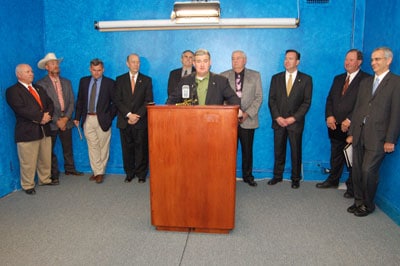Oklahoma is a National Leader in Documented Water Quality Success Stories
Project Area Details
On Wednesday, April 13, 2011, during Agriculture Day at the Capitol, leaders from Oklahoma’s Conservation Partnership held a press conference to announce newly-documented water quality success stories and the state’s position as a national leader in water quality improvement.

The dedicated work of farmers, ranchers and other landowners to control nonpoint source pollution in Oklahoma by using voluntary programs administered by the Oklahoma Conservation Commission and local conservation districts is paying off according to new water quality numbers recently reported on the Environmental Protection Agency (EPA) website. Water quality numbers released at the beginning of March show that nearly 440,000 pounds of nitrogen, 150,000 lbs of phosphorous and 6,000 tons of sediment was reduced from Oklahoma’s water last year.
• Numbers for 2010 rank Oklahoma among the top five states in controlling nonpoint source water pollutants nitrogen and phosphorus for the second year in a row.
• Oklahoma ranks in the top ten for the third year in a row while receiving less than one percent federal EPA nonpoint source funds.
• The EPA website lists 16 water quality success stories from Oklahoma. (www.epa.gov/owow/NPS/success/)
• Only two states in the nation have more water quality success stories.
These successes represent the results of cooperative efforts between the local landowners, local conservation districts Oklahoma Conservation Commission and the USDA Natural Resources Conservation Service (NRCS) to achieve the voluntary, cost-shared implementation of best management practices (BMPs) to improve water quality and the water quality monitoring efforts to prove it.
“We should all take pride in this accomplishment,” said state Sen. Ron Justice, chairman of the Oklahoma Senate Natural Resources Appropriations Sub-Committee. “This shows what can happen when we work together to solve problems. When we respect folks’ private property rights and when the state and federal governments give them the financial and technical assistance they need to make changes, we can accomplish great things. ”
Rep. Phil Richardson, chairman of the House Agriculture, Wildlife and Environment Committee agreed.
“By using the delivery system consisting of the Oklahoma Conservation Commission, local conservation districts and NRCS, we have been able to use federal Clean Water Act dollars to partner with landowners in ways that are starting to turn the corner on some of our toughest water quality issues,” Richardson said. “We’re not only controlling pollution, but we are also taking into consideration the financial situation of the local landowner — something that the EPA seems to be reluctant to do. Clearly we have a great model here in Oklahoma.”
Don Armes, chairman of the House Natural Resources Appropriations Subcommittee agreed. “This approach shows that production agriculture and protecting the environment don’t have to be at cross purposes,” Armes said. “I can only hope that the federal government and other states will take notice of what we are doing here in Oklahoma.”
According to Clay Pope, Executive Director of the Oklahoma Association of Conservation Districts, this water quality success was achieved through voluntary cost-share efforts similar to those used by Conservation to address soil erosion since the dust bowl of the 1930’s. Through Funding from the EPA Clean Water Act Section 319 program, the Farm Services Agency (FSA) Conservation Reserve Enhanced Program (CREP), Farm Bill Conservation Programs administered by the NRCS, State Conservation Programs administered by the Conservation Commission and with local leadership from conservation districts, Pope said farmers, ranchers and other landowners are working to protect our natural resources.
“In the past, the government learned that it was best to work cooperatively with landowners to address environmental concerns.” Pope said. “By helping individuals with technical and financial assistance, farmers, ranchers and other landowners are willing to put their own money out of their own pocket into cost-share projects designed to address concerns like water quality. This approach worked to tame the dust bowl and this recent recognition by the EPA shows it can also work to address non-point source pollution. By working cooperatively with landowners we can get a handle on these issues. This high ranking in the area of water quality success proves it!”
The water quality successes recently posted to the EPA website are
• Cooper Creek – Central Oklahoma
• Bull Creek – Northeast Oklahoma
• Cloud Creek – Eastern Oklahoma
• Dugout Creek – Central Oklahoma
• Dirty and Elk Creeks (two creeks in one story) – Eastern Oklahoma
• Mission Creek – Northeast Oklahoma
• Little Wewoka Creek – Central Oklahoma
Success stories posted previously are
• Beaty Creek – Northeast Oklahoma
• California Creek – Northeast Oklahoma
• Lake Creek – Central Oklahoma
• Little Elk Creek – Southwest Oklahoma
• Sandy & Yellowstone Creeks (two creeks in one story) North Central Oklahoma
• Wolf Creek – Northwest Oklahoma
• Peacheater Creek (not delisted but making progress) Northeast Oklahoma
In general, BMPs focused on improving grazing land and crop land and protecting riparian areas.
Typical BMPs included:
• Grazing Management
• Cross-fencing
• Alternative water supplies
• Supplemental hay planting
• Brush and weed management
• Nutrient management
• Heavy use area protection
• Conservation tillage (no-till, mulch till, or strip till)
• Conservation crop rotations
• Waste storage facilities
• Contour farming (terraces, diversions, waterways)
• Riparian (streambank and nearby area) fencing
The effect of these practices on reducing erosion of soils from upland and riparian areas is evident in that seven of the eight streams had improved turbidity. Improved dissolved oxygen values indicate reduced nutrient runoff, and improved bacteria levels also resulted in one stream.
Funding for the implementation of these practices came from NRCS and EPA programs (federal funds), local conservation cost-share (state funds), and from the participating landowners.
